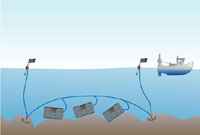 Pots and creels are traps, baited with fresh or salted fish, which are laid on the seabed and primarily used to catch shellfish. Pots and creels are a selective method of fishing. Small individuals can escape the traps and the shellfish are brought aboard live so any unwanted catch can be return to the sea unharmed. Large vessels on long fishing trips will keep their shellfish in live holding tanks onboard, while small vessels tend to land their catch daily.
Pots and creels are traps, baited with fresh or salted fish, which are laid on the seabed and primarily used to catch shellfish. Pots and creels are a selective method of fishing. Small individuals can escape the traps and the shellfish are brought aboard live so any unwanted catch can be return to the sea unharmed. Large vessels on long fishing trips will keep their shellfish in live holding tanks onboard, while small vessels tend to land their catch daily.
Examples of target species
- Crab, lobster, whelk, langoustines and octopus.
Environmental summary
- Habitat damage - pots and creels sit on the seabed so can be associated with disturbance to marine habitat but are not typically damaging.
- Bycatch of vulnerable species - pots and creels are not particularly associated with unintentional capture of vulnerable species.
- Discards - pots and creels can be associated with capture of non-target fish, juvenile commercial species and other marine life but this is not ordinarily a significant problem.
- Ghost fishing - when made of unbiodegradable plastic and wire, lost or unchecked pots and creels can continue catching animals in the water for a long time.
Mitigation
Escape panels can be incorporated into the traps to allow small fish and shellfish to avoid capture.
Good Catch: Good Catch provides practical information for chefs, caterers and restaurateurs, making it easier for them to serve more sustainable seafood.
